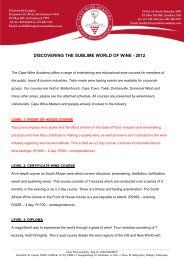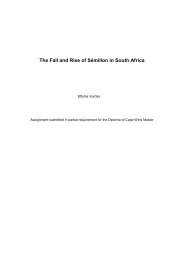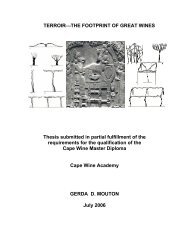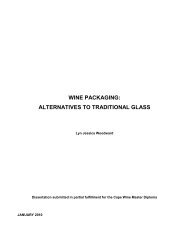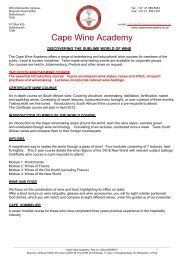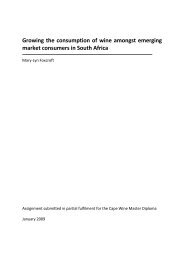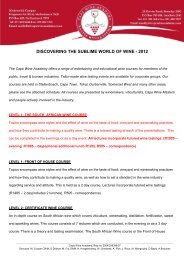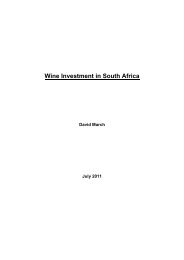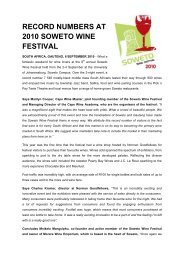micro-oxygenation in contemporary winemaking - Cape Wine ...
micro-oxygenation in contemporary winemaking - Cape Wine ...
micro-oxygenation in contemporary winemaking - Cape Wine ...
Create successful ePaper yourself
Turn your PDF publications into a flip-book with our unique Google optimized e-Paper software.
Micro-<strong>oxygenation</strong> <strong>in</strong> Contemporary W<strong>in</strong>emak<strong>in</strong>gsubsequent barrel maturation (Cano-Lopez et al., 2007) so that the f<strong>in</strong>al impact oftreatment was reduced.W<strong>in</strong>e flavonols (quercet<strong>in</strong>, myricet<strong>in</strong> etc – see Table 12) have been consistently reduced by<strong>micro</strong>-<strong>oxygenation</strong> treatment <strong>in</strong> all of the studies that have measured these compounds(Castellari et al., 2000; Sart<strong>in</strong>i et al., 2007; de Beer et al., 2008; Kovacevic Ganic et al.,2008). This is of some concern because flavonols are an important contributor to w<strong>in</strong>eanti-oxidant capacity (Parker et al., 2007).The impact of <strong>micro</strong>-<strong>oxygenation</strong> on tann<strong>in</strong> polymerisation (as measured by the MDP) isalso mixed. Atanasova et al (2002) and del Carmen-Laudy et al (2006) found an <strong>in</strong>crease<strong>in</strong> MDP whereas Pour-Nikfardjam & Dykes (2003) showed a decrease <strong>in</strong> MDP relative tocontrols. Cano-Lopez et al (2008) measured an <strong>in</strong>crease <strong>in</strong> MDP <strong>in</strong> one w<strong>in</strong>e that startedwith a lower phenolic concentration (perhaps suggest<strong>in</strong>g over-treatment with oxygen) but adecreased MDP <strong>in</strong> w<strong>in</strong>es that were <strong>in</strong>itially more tannic.Although, most studies demonstrated a decrease <strong>in</strong> total phenolic or monomeric tann<strong>in</strong>s,there is no consistent evidence on the actual impact of MOX on astr<strong>in</strong>gency and mouthfeel.The chemistry of astr<strong>in</strong>gency is complex (Gawel, 1998; Francis et al., 2002), and althoughage<strong>in</strong>g promotes tann<strong>in</strong> polymerisation this may well <strong>in</strong>crease rather than decreaseastr<strong>in</strong>gency (Vidal et al., 2003; Gawel et al., 2007).7.4.3 Impact on Aroma CompoundsMcCord’s research <strong>in</strong> 2003 suggested that <strong>micro</strong>-<strong>oxygenation</strong> decreased sulphidereductive flavours (mercaptans) but this has not been confirmed <strong>in</strong> subsequent studies.Two recent studies measured a large number of aroma compounds <strong>in</strong> w<strong>in</strong>es treated withMOX (Ortega-Herás et al., 2008; Hernández-Orte et al., 2009) but found no consistent<strong>in</strong>crease <strong>in</strong> fruit<strong>in</strong>ess or decrease <strong>in</strong> green herbaceous flavours, which are key claims of the<strong>in</strong>dustry. Also, both studies demonstrated that treated w<strong>in</strong>es take up less wood compoundson subsequent barrel maturation (Table 19).7.4.4 Impact on W<strong>in</strong>e Anti-oxidant ActivityThe decrease <strong>in</strong> total phenols produced by <strong>micro</strong>-<strong>oxygenation</strong> would be expected todecrease total anti-oxidant activity. This may have implications for the claimed healthbenefits of red w<strong>in</strong>e. To date only two studies has evaluated this directly (de Beer et al.,2008; Rivero-Pérez et al., 2008). De Beer et al (2008) found that w<strong>in</strong>e total anti-oxidant64



